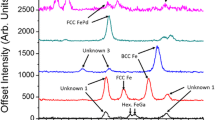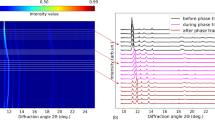Abstract
Convergent Beam Electron Diffraction (CBED) images are 2D diffraction patterns created through the interaction between the fired electron and the atoms of a crystalline structure. Due to the absence of geometric mapping between three-dimensional structures and two-dimensional projections in this process, traditional image processing methods cannot classify CBED images into crystallographic space groups with high accuracy. The problem gets exacerbated by the class imbalance in the dataset. To effectively bridge the gaps in our understanding of solid-state crystalline structures, we must build a classifier capable of classifying diffraction patterns such as CBED images into crystallographic space groups while addressing the class imbalance. In this project, we explore the sources and nature of classification difficulties to gather insight into building a robust classifier. We first built some naive classifiers on the subset of classes by augmenting ResNet50 in various schemes. We developed a novel multi-level classification technique, called Trickle Down Classifier (TDC) to address the class imbalance in scientific datasets. TDC consists of multiple levels of subset classifiers. At each level, TDC trains a classifier to allocate the samples into a subset of classes. TDC forwards samples missed by a component classifier at a particular level to the next level classifier. For the top 20 classes, the TDC performs at an estimated \(34\%\) accuracy compared to a naive classifier’s \(14\%\) accuracy.
S. Dash and A. Dasgupta—These authors contributed equally to this work.
Access this chapter
Tax calculation will be finalised at checkout
Purchases are for personal use only
Similar content being viewed by others
References
Chawla, N.V., Bowyer, K.W., Hall, L.O., Kegelmeyer, W.P.: Smote: synthetic minority over-sampling technique. J. Artif. Intell. Res. 16, 321–357 (2002)
Chen, T., He, T., Benesty, M., Khotilovich, V., Tang, Y.: Xgboost: extreme gradient boosting. R package version (4-2), 1–4 (2015)
Dasgupta, A., Handosa, M., Manuel, M., Gračanin, D.: A User-centric design framework for smart built environments. In: Streitz, N., Konomi, S. (eds.) HCII 2019. LNCS, vol. 11587, pp. 124–143. Springer, Cham (2019). https://doi.org/10.1007/978-3-030-21935-2_11
Dasgupta, A., Manuel, M., Mansur, R.S., Nowak, N., Gračanin, D.: Towards real time object recognition for context awareness in mixed reality: a machine learning approach. In: 2020 IEEE Conference on Virtual Reality and 3D User Interfaces Abstracts and Workshops (VRW), pp. 262–268. IEEE (2020)
Dash, S.: Exploring the landscape of big data analytics through domain-aware algorithm design. Ph.D. thesis, Virginia Tech (2020)
Dash, S., Rahman, S., Hines, H.M., Feng, W.C.: Incremental blast: incremental addition of new sequence databases through e-value correction. bioRxiv, p. 476218 (2018)
Han, H., Wang, W.-Y., Mao, B.-H.: Borderline-SMOTE: a new over-sampling method in imbalanced data sets learning. In: Huang, D.-S., Zhang, X.-P., Huang, G.-B. (eds.) ICIC 2005. LNCS, vol. 3644, pp. 878–887. Springer, Heidelberg (2005). https://doi.org/10.1007/11538059_91
He, K., Zhang, X., Ren, S., Sun, J.: Deep residual learning for image recognition. In: Proceedings of the IEEE Conference on Computer Vision and Pattern Recognition, pp. 770–778 (2016)
Kaufmann, K., et al.: Paradigm shift in electron-based crystallography via machine learning. arXiv preprint arXiv:1902.03682 (2019)
Kaufmann, K., Zhu, C., Rosengarten, A.S., Maryanovsky, D., Harrington, T.J., Marin, E., Vecchio, K.S.: Crystal symmetry determination in electron diffraction using machine learning. Science 367(6477), 564–568 (2020)
Kaufmann, K., Zhu, C., Rosengarten, A.S., Vecchio, K.S.: Deep neural network enabled space group identification in EBSD. Microsc. Microanal. 26(3), 447–457 (2020)
Laanait, N., Yin, J., Borisevich, A.: Towards a universal classifier for crystallographic space groups (2020). https://smc-datachallenge.ornl.gov/challenges-2020/challenge-2-2020/
Liang, S., Srikant, R.: Why deep neural networks for function approximation? arXiv preprint arXiv:1610.04161 (2016)
Ren, X., Guo, H., Li, S., Wang, S., Li, J.: A novel image classification method with CNN-XGBoost model. In: Kraetzer, C., Shi, Y.-Q., Dittmann, J., Kim, H.J. (eds.) IWDW 2017. LNCS, vol. 10431, pp. 378–390. Springer, Cham (2017). https://doi.org/10.1007/978-3-319-64185-0_28
Sergeev, A., Del Balso, M.: Horovod: fast and easy distributed deep learning in tensorflow. arXiv preprint arXiv:1802.05799 (2018)
Tasooji, R., Dasgupta, A., Gračanin, D., LaGro, M., Matković, K.: A multi-purpose IOT framework for smart built environments. In: Proceedings of the 2018 Winter Simulation Conference, pp. 4240–4241. IEEE Press (2018)
Yen, S.J., Lee, Y.S.: Cluster-based under-sampling approaches for imbalanced data distributions. Expert Syst. Appl. 36(3), 5718–5727 (2009)
Yin, J., et al.: Strategies to deploy and scale deep learning on the summit supercomputer. In: 2019 IEEE/ACM Third Workshop on Deep Learning on Supercomputers (DLS), pp. 84–94. IEEE (2019)
Acknowledgement
Part of this work has benefited from a collaborative work with our friends and collaborators Shubhankar Gahlot, Rohan Dhamdhere, and Mohammad Alaul Haque Monil.
Author information
Authors and Affiliations
Corresponding author
Editor information
Editors and Affiliations
Rights and permissions
Copyright information
© 2020 Springer Nature Switzerland AG
About this paper
Cite this paper
Dash, S., Dasgupta, A. (2020). Towards a Universal Classifier for Crystallographic Space Groups: A Trickle-Down Approach to Handle Data Imbalance. In: Nichols, J., Verastegui, B., Maccabe, A.‘., Hernandez, O., Parete-Koon, S., Ahearn, T. (eds) Driving Scientific and Engineering Discoveries Through the Convergence of HPC, Big Data and AI. SMC 2020. Communications in Computer and Information Science, vol 1315. Springer, Cham. https://doi.org/10.1007/978-3-030-63393-6_31
Download citation
DOI: https://doi.org/10.1007/978-3-030-63393-6_31
Published:
Publisher Name: Springer, Cham
Print ISBN: 978-3-030-63392-9
Online ISBN: 978-3-030-63393-6
eBook Packages: Computer ScienceComputer Science (R0)





